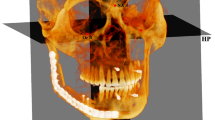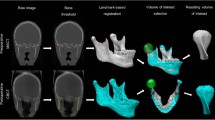Abstract
Objectives
To establish one method that can be used to quantitatively evaluate the condyle positional changes with 3D images in postoperative mandibular prognathism patients.
Materials and methods
This is a retrospective observational study. Twenty-one patients who underwent bilateral sagittal split ramus osteotomy (BSSRO) were scanned with cone beam computed tomography (CBCT) for temporomandibular joints (TMJs) at 1 week preoperatively (T0), 1 to 2 weeks (T1), 3 months (T2), 6 months (T3), and 12 months (T4) postoperatively. The data were then grouped into T0T1, T1T2, T2T3, T3T4 and T0T1, T0T2, T0T3, and T0T4. Semi-automatic registration was conducted, and the condyle positional changes were measured in segmented 3D models. Inter- and intra-observer variability and the repeatability of registration were analyzed with paired t test; the repeated measurement analysis of variance was used for analyzing the repeatability of the marked points; the consistency of segmentation was analyzed with nonparametric test of multiple paired samples (Friedman test) and the independent-sample t test was applied to comparing changes between different periods of time. Differences were considered to be statistically significant when P < 0.05.
Results
In T0T1 and T1T2, the condylar position was changed greatly. In T2T3, the mean condylar translations were less than 0.2 mm in all directions, the mean rotational changes of condyle were less than 0.2 mm; in the period of T3T4, the mean condylar translations in all directions were less than 0.02 mm. For series 2, the condyle translational changes in axial, coronal, and sagittal views were within 0.10 mm, and the rotation direction of condyle in all three views was the same within 1 year after operation.
Conclusions
Fused three-dimensional images can be used to qualitatively and quantitatively evaluate condyle positional changes. The condylar position might be stable at 3 months postoperatively. The condyles of most of patients did not fully return to their preoperative position within 1 year after the operation.
Clinical relevance
One method for fusing images has been established to detect the condylar positional changes. This method may be applied to estimate the bony changes of condyle, even bony changes in other part of dentomaxillofacial region. Meanwhile, the data of condyle positional changes from asymptomatic patients after the surgery within 1 year can be used as a reference for further exploration of the relationship between orthognathic surgery and the occurrence of osteoarthritis postoperatively in the future.
Key Points
• By fused 3D images, the change of condylar position after bilateral sagittal split ramus osteotomy can be observed intuitively.
• For the patients with mandibular prognathism, the condylar position would be stable at 3 months postoperatively.
• The condyles of most mandibular prognathism patients did not fully return to their preoperative position within 1 year after operation.






Similar content being viewed by others
Abbreviations
- CBCT:
-
cone beam computed tomography
- BSSRO:
-
bilateral sagittal split ramus osteotomy
- TMJ:
-
temporomandibular joint
- 3D:
-
three-dimensional
- DICOM:
-
digital imaging and communications in medicine
- FOV:
-
field of view
References
Choi BJ, Choi YH, Lee BS, Kwon YD, Choo YJ, Ohe JY (2014) A CBCT study on positional change in mandibular condyle according to metallic anchorage methods in skeletal class III patients after orthognatic surgery. J Craniomaxillofac Surg 42:1617–1622
Chen S, Lei J, Wang X, Fu KY, Farzad P, Yi B (2013) Short- and long-term changes of condylar position after bilateral sagittal split ramus osteotomy for mandibular advancement in combination with Le Fort I osteotomy evaluated by cone-beam computed tomography. J Oral Maxillofac Surg 71:1956–1966
Wang HY, Duan Y, Tian X, Xiao H (2012) Changes in mandibular condyle positions before and after bilateral sagittal split ramus osteotomy for mandibular prognsthism (Article in Chinese). Chin J Conserv Dent 22:33–35
Joss CU, Vassalli IM (2009) Stability after bilateral sagittal split osteotomy advancement surgery with rigid internal fixation: a systematic review. J Oral Maxillofac Surg 67:301–313
Frey DR, Hatch JP, Van Sickels JE, Dolce C, Rugh JD (2008) Effects of surgical mandibular advancement and rotation on signs and symptoms of temporomandibular disorder: a 2-year follow-up study. Am J Orthod Dentofacial Orthop 133:490.e1-8.
Dujoncquoy JP, Ferri J, Raoul G, Kleinheinz J (2010) Temporomandibular joint dysfunction and orthognathic surgery: a retrospective study. Head Face Med 6:27
Abrahamsson C, Ekberg E, Henrikson T, Bondemark L (2007) Alterations of temporomandibular disorders before and after orthognathic surgery: a systematic review. Angle Orthod 77:729–734
Ueki K, Moroi A, Sotobori M, Ishihara Y, Marukawa K, Yoshizawa K, Kato K, Kawashiri S (2012) Changes in temporomandibular joint and ramus after sagittal split ramus osteotomy in mandibular prognathism patients with and without asymmetry. J Craniomaxillofac Surg 40:821–827
Draenert FG, Erbe C, Zenglein V, Kämmerer PW, Wriedt S, Al Nawas B (2010) 3D analysis of condylar position after sagittal split osteotomy of the mandible in mono- and bimaxillary orthognathic surgery - a methodology study in 18 patients. J Orofac Orthop 71:421–429
Schilling J, Gomes LC, Benavides E et al (2014) Regional 3D superimposition to assess temporomandibular joint condylar morphology. Dentomaxillofac Radiol 43:20130273
Paniagua B, Pera J, Budin F et al (2015) Validation of Osteoarthritis synthetic defect database via non-rigid registration. Proc SPIE Int Soc Opt Eng 9417
Carvalho Fde A, Cevidanes LH, da Motta AT, Almeida MA, Phillips C (2010) Three-dimensional assessment of mandibular advancement 1 year after surgery. Am J Orthod Dentofacial Orthop 137(4 Suppl): S53.e1-12; discussion S53-55.
Méndez-Manjón I, Guijarro-Martínez R, Valls-Ontañón A, Hernández-Alfaro F (2016) Early changes in condylar position after mandibular advancement: a three-dimensional analysis. Int J Oral Maxillofac Surg 45:787–792
Motta AT, de Assis Ribeiro Carvalho F, Cevidanes LH, de Oliveira Almeida MA (2010) Assessment of mandibular advancement surgery with 3D CBCT models superimposition. Dental Press J Orthod 15:45e1–45e12
Han YS, Jung YE, Song IS, Lee SJ, Seo BM (2016) Three-Dimensional Computed Tomographic Assessment of Temporomandibular Joint Stability After Orthognathic Surgery. J Oral Maxillofac Surg 74:1454–1462
Kim YJ, Oh KM, Hong JS et al (2012) Do patients treated with bimaxillary surgery have more stable condylar positions than those who have undergone single-jaw surgery? J Oral Maxillofac Surg 70:2143–2152
Zafar H, Choi DS, Jang I, Cha BK, Park YW (2014) Positional change of the condyle after orthodontic-orthognathic surgical treatment: is there a relationship to skeletal relapse? J Korean Assoc Oral Maxillofac Surg 40:160–168
Neves FS, Vasconcelos TV, Vaz SL, Freitas DQ, Haiter-Neto F (2012) Evaluation of reconstructed images with different voxel sizes of acquisition in the diagnosis of simulated external root resorption using cone beam computed tomography. Int Endod J 45:234–239
Menezes CC, Janson G, da Silveira MC, Cambiaghi L, Garib DG (2016) Precision, reproducibility, and accuracy of bone crest level measurements of CBCT cross sections using different resolutions. Angle Orthod 86:535–542
Cheng JG, Zhang ZL, Wang XY, Zhang ZY, Ma XC, Li G (2012) Detection accuracy of proximal caries by phosphor plate and cone-beam computerized tomography images scanned with different resolutions. Clin Oral Investig 16:1015–1021
Motta AT, Cevidanes LH, Carvalho FA, Almeida MA, Phillips C (2011) Three-dimensional regional displacements after mandibular advancement surgery: one year of follow-up. J Oral Maxillofac Surg 69:1447–1457
Kobayashi T, Izumi N, Kojima T, Sakagami N, Saito I, Saito C (2012) Progressive condylar resorption after mandibular advancement. Br J Oral Maxillofac Surg 50:176–180
Park SB, Yang YM, Kim YI, Cho BH, Jung YH, Hwang DS (2012) Effect of bimaxillary surgery on adaptive condylar head remodeling: metric analysis and image interpretation using cone-beam computed tomography volume superimposition. J Oral Maxillofac Surg 70:1951–1959
Funding
This study has received funding by National Natural Science Foundation of China (No. 81671034).
Author information
Authors and Affiliations
Corresponding author
Ethics declarations
Conflict of interest
The authors declare that they have no conflict of interest.
Ethical approval
All procedures performed in the study involving human participants were in accordance with the ethical standards of Institutional Review Board of Peking University School and Hospital of Stomatology (PKUSSIRB-201944056) and with the 1964 Helsinki declaration and its later amendments or comparable ethical standards.
Informed consent
Written informed consent was not required for this study because all of the included patients in the present investigation were collected retrospectively. Exemption of informed consent will not affect the rights and health of included patients. The application for free informed consent has been approved by the Institutional Review Board.
Additional information
Publisher’s note
Springer Nature remains neutral with regard to jurisdictional claims in published maps and institutional affiliations.
Rights and permissions
About this article
Cite this article
Ma, Rh., Li, G., Yin, S. et al. Quantitative assessment of condyle positional changes before and after orthognathic surgery based on fused 3D images from cone beam computed tomography. Clin Oral Invest 24, 2663–2672 (2020). https://doi.org/10.1007/s00784-019-03128-z
Received:
Accepted:
Published:
Issue Date:
DOI: https://doi.org/10.1007/s00784-019-03128-z




